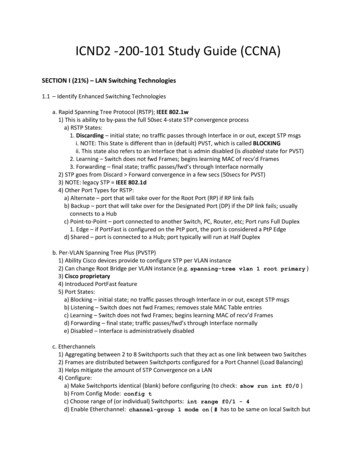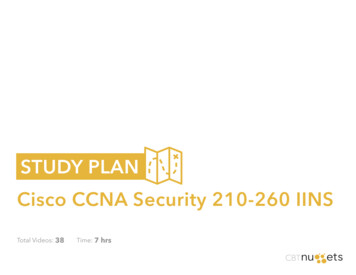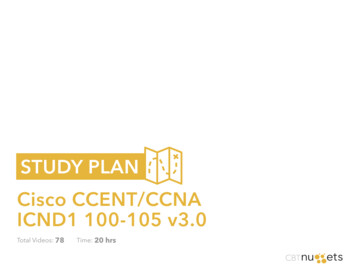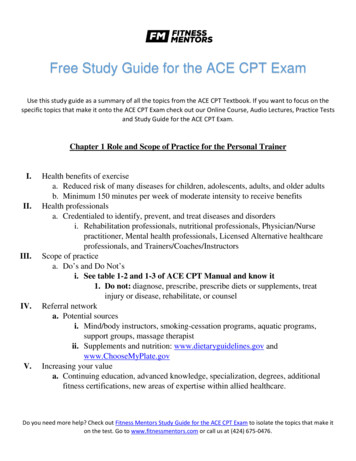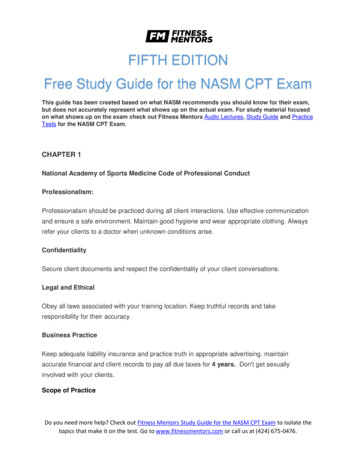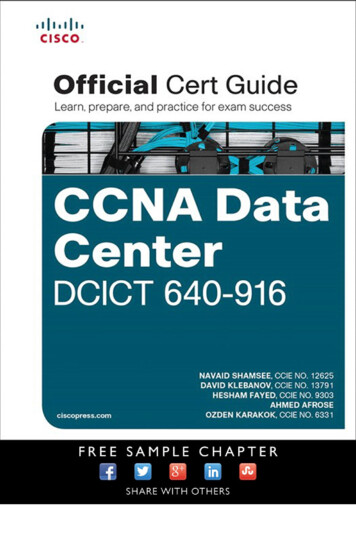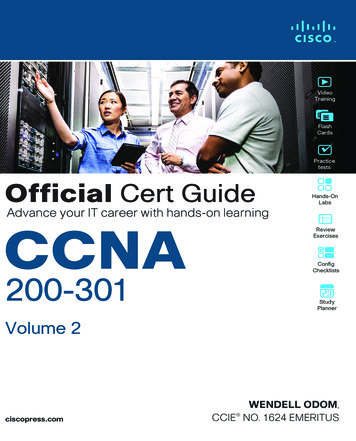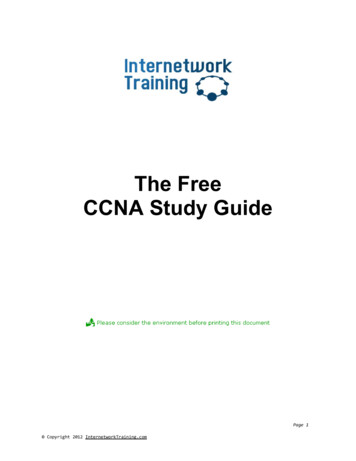
Transcription
The FreeCCNA Study GuidePage 1 Copyright 2012 InternetworkTraining.com
IntroductionWe decided to put together this free CCNA study guide after we received a large number ofrequests from our visitors for free CCNA training.Whilst it is quite feasible that you could pass using just the information and links containedwithin this free guide, it is more of an introduction to the CCNA course, for you to evaluatewhether the CCNA is right for you.At the time of writing, the CCNA exam costs US 250, it is not an easy exam to pass, if you tryand sit the exam without structured training you might as well send us a cheque for 250.If you want ensure you learn the whole CCNA syllabus, including Cisco IOS configuration andtroubleshooting (not covered in this guide), as well as making your study time easier and moreenjoyable, while increasing your chances of passing the exam, enroll on our CCNA Bootcampand get first class video training online for an unbeatable price!Early NetworkingBefore networks existed people used to share files bysneakernet, basically passing floppy disks to one another. Itwasn't long before the Local Area Network was born, whichenabled network hosts to communicate with each other via hubsby installing network interface cards.Each network host has a physical address, known as the MACaddress and logical address, known as the IP address. Whenhosts are connected to a hub, they are in the same collisionand broadcast domain. Network switches do a similar job tohubs, however they break up collision domains making a LANmore efficient.LANs link hosts together in small areas such as offices and schools. To communicate betweenLANs they must be connected to Wide Area Networks (WANs) using routers.The internet is the biggest WAN and uses the Domain Name System to translate domain namesinto IP addresses that networking devices understand and communicate with.Page 2 Copyright 2012 InternetworkTraining.com
The OSI modelThe Open Systems Interconnection (OSI) model is astandard model used in networking to abstract the processesinvolved in network communication. It consists of sevenlayers:The Application layer, Presentation layer, Session layer,Transport layer (which uses flow control andacknowledgements), the Network layer, the Data link layerand the Physical layer.Each layer has its own protocol data unit which encapsulatesthe data received from the upper layers.The OSI model is fundamental to networking theory andtroubleshooting, so make sure you understand andmemorize what is happens at each layer.The TCP/IP modelThe TCP/IP protocol suite is the closest implementation of the OSImodel there is, it consists of only four layers. The Application layer,Transport layer, Internet layer and Link layer.There are a lots of similarities between the OSI model and the TCP/IP model.The transport layer contains a reliable protocol called TCP and anunreliable protocol called UDP. To enable the transport layer toallow multi-protocol communication between hosts it uses portnumbers.The network layer features the routed protocol called IP protocoland Internet Control Message Protocol (ICMP).TCP/IP ProtocolsThe TCP/IP suite contains lots of protocols that operate at various layers, including Telnet, FTP,TFTP, NFS, POP, SMTP, SNMP, DNS, DHCP, TCP, UDP, IP, ICMP, ARP and RARP. You willneed a good understanding of each of these protocols.Page 3 Copyright 2012 InternetworkTraining.com
Binary and Hexadecimal Numbering SystemsThe binary numbering system is the numbering system natively used by computers.Binary consists of ones and zeros. A single one or zero is called a bit. A byte is eight bits, and anibble is just four bits.The hexadecimal numbering system is used for network addressing in IP version 6.You need to be familiar with converting between decimal, hexadecimal and binary for the exam.Local Area Networks (LANs)A Local Area Network (LAN) is a computer network within aoffice, school or home.LANs can have different network topologies and differentcabling types such as UTP category 5, single mode fiber,and multi-mode fiber. Some cables are susceptible tocrosstalk and/or electromagnetic interference.Ethernet is the most common type of LAN today, it is definedby the IEEE 802.3 standard and uses the Ethernet frame, itis a broadcast transmission technology which means framecollisions can occur, which are dealt with by Carrier SenseMultiple Access with Collision Detection (CSMA/CD).Ethernet cabling standards are defined by the TIA/EIA standards.Ethernet was originally a half-duplex technology, but can now be either full or half-duplex.Network devices are connected together using either crossover or straight-through cablesdepending on the devices you are connecting together.Cisco Hierarchical ModelCisco developed a three-layer model to help networkengineers design efficient and scalable networks. It hasthree layers. The core, distribution and access layer.Page 4 Copyright 2012 InternetworkTraining.com
Cisco IOSCisco IOS is the operating system software used onmost Cisco routers and switches.It features an IOS command line interface used toconfigure the devices.You will need to learn IOS configuration andtroubleshooting to pass your CCNA exam.IP AddressingEach network device requires a logical layer 3 IP address to beable to communicate over the network. IP version 4 addressesuse dotted decimal notation and consist of 4 octets.There are three different classes of IP address. A, B, C, andeach class has its own private IP address range for use within aLAN, which are not routable over WANs.There are also a number of reserved IP addresses that are reserved for special purposes.For example: the IP address 127.0.0.1 is called the loopback address and is used totroubleshoot the TCP/IP stack on a host.SubnettingSubnetting is the process of dividing an IPv4 network into a number of smaller subnetworks.A subnet mask is used by network hosts to determine the subnet. CIDR notation is often used toabbreviate the subnet mask.You will need to know how to subnet a network using a pen and paper in the exam.Our premium account includes our excellent Subnetting Made Easy eBook which will help youlearn how to subnet, sign-up here!Page 5 Copyright 2012 InternetworkTraining.com
IP Version 6IP version 6 is the next version of Internet Protocol. It was created to solve the problem ofdiminishing available IPv4 addresses due to the exponential increase in the number of thedevices connected to the internet.IPv6 addresses are expressed in hexadecimal, and devices can send unicast, multicast andanycast datagrams, but not broadcasts.IPv6 uses newer versions of DHCP and ICMP (DHCPv6 and ICMPv6).Layer 2 SwitchingLayer 2 switches improve network performance by reducing the size of collision domains,resulting in less collisions on the network. Switches and bridges use MAC addresses to reducetraffic on the network by only sending frames to the network segments which contain thedestination hosts. In contrast, hubs repeat the frames out all ports.Switches can use three different types of switching techniques, Cut-through, store-and-forwardand fragment free.The Spanning Tree Protocol (STP)The Spanning Tree Protocol is used to prevent switching loops from causing problems on aswitched network. Switching loops are caused when redundant links are added to a network toprovide resilience. STP is defined by the IEEE 802.1D standard.Page 6 Copyright 2012 InternetworkTraining.com
Virtual LANs (VLANs)Virtual LANs are logical LANs created on existing hardware. They allow traffic and users on aLAN to be logically grouped together. VLANs can be shared between multiple switches by usingVLAN trunking, enabling users to be grouped by function regardless of their physical location.VLAN trunking can be implemented on trunk ports using either IEEE 802.1Q and Cisco ISLtrunking protocols.Management of VLANs can then be centralized using a VLAN Management Policy Server.EtherChannel is a method of creating redundant high-bandwidth logical trunk links betweenswitches.Voice over IP (VoIP)Voice over IP (VoIP) is a set of technologies enabling voicecommunications over IP networks.Quality of Service and Class of Service are used to prioritize voicetraffic to enhance the call quality.RoutingRouting is the process of determining the best path to forward layer 3 packets to theirdestination.Routers use dynamic routing to choose the best route through the internetwork, these routesupdate automatically when the network changes by using routing protocols. Administrators canalso configure static and default routes.Each routing protocol has an administrative distance and metrics such as hop count to help therouter to determine the best route.Routing protocols can be categorized as either distance vector, link state or hybrid.Be sure you know the difference between routed and routing protocols!Routing Information Protocol (RIP)Routing Information Protocol (RIP) is a distance vector routing protocol that uses the BellmanFord algorithm to determine the best route to forward packets.RIP is an interior gateway protocol that uses hop count as its only metric. It also uses SplitPage 7 Copyright 2012 InternetworkTraining.com
Horizon and poison reverse to prevent routing loops. There are two versions of RIP, RIPv1 is aclassful routing protocol, whereas RIPv2 is classless.Enhanced Interior Gateway Routing Protocol (EIGRP)Enhanced Interior Gateway Routing Protocol (EIGRP) is a Cisco proprietary routing protocolwhich uses a number of metrics, and an algorithm called the Diffusing Update Algoithm (DUAL)to make its routing decisions. Cisco refers to EIGRP as a hybrid routing protocol because it hascharacteristics of both Distance Vector and Link State routing protocols.Open Shortest Path First (OSPF)Open Shortest Path First (OSPF) is a non-proprietary Link-State interior gateway routingprotocol operating in a single autonomous system, it uses the Dijkstra algorithm.Wireless LAN (WLAN)WLAN is a set of technologies defined by the IEEE 802.11 standardthat enable wireless network access. WLAN can operate in eitherad-hoc mode or infrastructure mode using a wireless access point.Each access point has an Service Set Identifier (SSID) to enableusers to easily discover and connect.There are several 802.11 standards which use either 5GHz or2.4GHz bands and different frequency modulation techniquesincluding DSSS, OFDM and Mimo.WLAN is susceptible to interference and being cracked, there areseveral security protocols such as the insecure WEP and WPAwhich was developed by the Wi-Fi Alliance.WLAN uses Collision Sense Multiple Access/Collision Avoidance (CSMA/CA) rather CSMA/CDused by Ethernet.Page 8 Copyright 2012 InternetworkTraining.com
Network Security BasicsLack of network security can be costly to a business. Networksare under almost constant attack from password cracking, trojanhorses, keylogging, denial of service, IP spoofing and man-in-themiddle to name a few.Network administrators have a range of tools to mitigate the riskof attack including firewalls, DMZ, access control lists and context-based access control devices.IP Access ListsAccess Control Lists (ACL) are a method of filtering traffic based on destination, source IPaddress or protocol and port numbers.There are three types of Cisco ACL, standard access lists, extended access lists and namedaccess lists.Wildcard masks can be used to apply a filter to a range of IP addresses.Wide Area Networks (WANs)A Wide Area Network (WAN) connects LANs together over long distances. At each end ofthe WAN connection you either have Data Communications Equipment (DCE) or Data circuitTerminating Equipment (DTE). The DCE is usually located at the service provider whereas theDTE is customer premise equipment.There are numerous WAN technologies which are classed as either circuit switching, packetswitching or cell relay.You need to understand the following WAN technologies, HDLC, PPP, Frame Relay, and ATM.Network Address Translation (NAT)Network Address Translation (NAT) is a process of changing the IP address of packets as theytravel in and out of a network.There are several different types of NAT. Static, Dynamic and Port Address Translation.NAT has become a useful tool to mitigate the effects of IPv4 IP address exhaustion.Virtual Private Networks (VPN)Virtual Private Network (VPN) is a technology that creates a secure private connection betweentwo end-points over a public network such as the internet.VPN has become popular because it is a cheap alternative to a permanent WAN connection.It works by creating an IP tunnel through the public network and secures the data using theIPsec protocol.Page 9 Copyright 2012 InternetworkTraining.com
High-Level Data Link Control (HDLC)HDLC is a ISO standard WAN encapsulation, although Cisco has created its own version ofHDLC which adds multiple layer 3 support.HDLC is the default encapsulation on serial interfaces of Cisco routers.Point-to-Point Protocol (PPP)Point-to-Point Protocol (PPP) is an industry standard WAN protocol that can be used oversynchronous and asynchronous circuits.PPP features Link Control Protocol (LCP) to initiate and terminate the connection and NetworkControl Protocol (NCP) to provide layer 3 encapsulation.PPP has two options for encryption, Password Authentication Protocol (PAP) and the moresecure Challenge Handshake Authentication Protocol (CHAP).Frame RelayFrame Relay is a high-performance packet-switching WAN protocol that features congestioncontrol.Data-Link Control Identifiers (DLCIs) are assigned by the service provider to identify the virtualcircuits. Local Management Interface (LMI) messages used to share virtual circuit status.Customers are guaranteed a maximum bandwidth by the service provider called the CommittedInformation rate (CIR).Page 10 Copyright 2012 InternetworkTraining.com
Other Free StuffIf you found this guide useful, sign-up for a free account at Internetwork Training and get
We decided to put together this free CCNA study guide after we received a large number of requests from our visitors for free CCNA training. Whilst it is quite File Size: 1MBPage Count: 13

